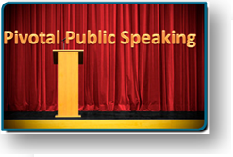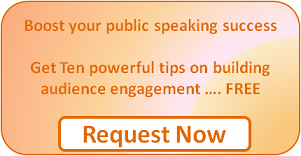|
|
|
How to be a Great Speaker - Tomorrow
Speaking to a trade or professional group-or to a client's employees-is really quite simple. If you're not a professional speaker and want to become one, or are one and want to do it better, here are some shortcuts in one concise article. (And these rules apply to managers at meetings, executives at conferences, presenters at board meetings, and anyone else seeking to influence an audience.)
1. Prepare an opening, body and ending. The opening should be about 2-5 minutes, and have a "hook" to attract people. An audience member decides in the first couple of minutes whether to pay attention to you or to start naming the state capitals. Use statistics, humor, demonstrations, provocative statements, or whatever it takes, to create rapt attention quickly. Don't hem and haw or apologize for not knowing how to use the mike.
The body should have five-to-ten points, each supported with facts, examples, anecdotes, stories, experiences, and whatever it takes to depart from the merely conceptual and reach the audience's pragmatic reality. Stories and examples are powerful tools to "bring home" a point. The body should consume about 90% of your talk.
2.
The end should have a summary and call to action, and last no more than 3-5 minutes. Let people know how you expect them to think or act differently. Never end on questions and answers. Save your summary and ending for the absolute conclusion. And make your final sentence loud and strong.
Use an outline with bullet points, which you've rehearsed. Never read a speech. This will ensure that you're conversational and natural. Glancing at your bullet point notes is fine-never memorize a speech.
3. Use humor sparingly and always in a self-deprecating manner. It's always all right to use yourself as the butt of a joke, and never all right to use anyone else. Don't use generic stories or stories you heard someone else tell. Think about funny things that have happened to you, and incorporate them, not for belly-laughs, but for a smile along the way.
4. If you're taking questions, designate a specific period so that you're not constantly interrupted. Repeat, respond to, and review each question. Repeat it so others can hear it clearly and give yourself time to consider your answer; respond to it, with an example, if possible; review with the questioner whether or not you answered the question to his or her satisfaction. (If you have a heckler or malicious question, then skip step three and immediately turn to someone else or continue your remarks.)
5. Never lose your temper or your cool, even if waiter drop dishes or two participants are talking while you are. Most members of any audience want you to succeed. They're with you unless you deliberately alienate them.
6. Finally, prepare carefully, deliver with enthusiasm, and then go home. Do your best and forget about it. The future of civilization as we know it is not riding on your performance. Cut yourself some slack. More Articles on preparing speeches
|
|
|
Supporting you as you pivot towards a better life, a better you ... Information research, packaging and presentation ... Inspiration --- Self Improvement --- Families --- For Teachers --- Books & Reading --- Business & Wealth --- Products---Quizzes & Tests---Quotations---Just for fun---Online courses
|



 Writing Great Speeches: Professional Techniques You
Can Use
Writing Great Speeches: Professional Techniques You
Can Use



